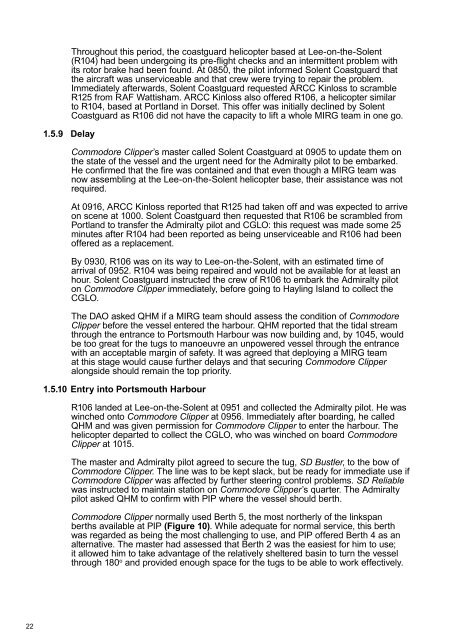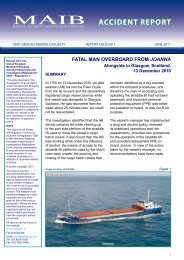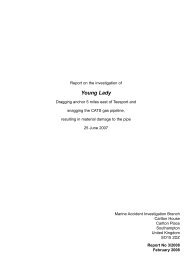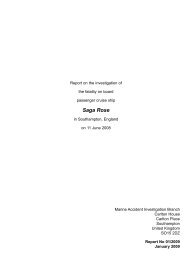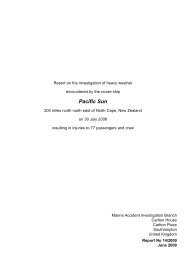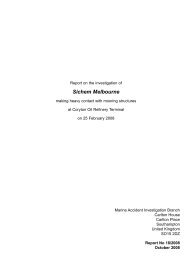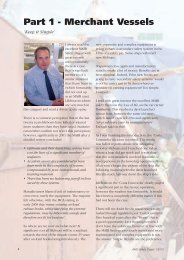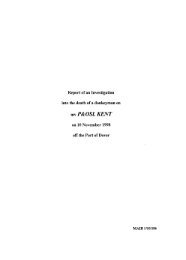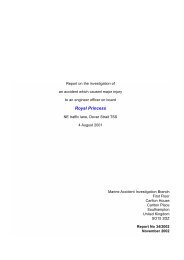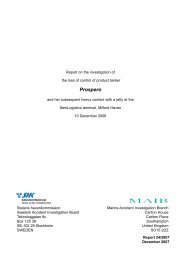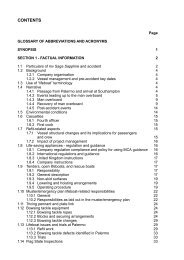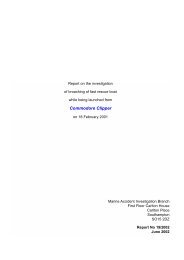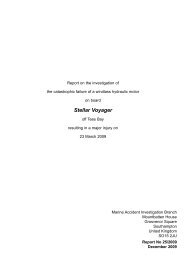Commodore Clipper - Marine Accident Investigation Branch
Commodore Clipper - Marine Accident Investigation Branch
Commodore Clipper - Marine Accident Investigation Branch
Create successful ePaper yourself
Turn your PDF publications into a flip-book with our unique Google optimized e-Paper software.
22<br />
1.5.9 Delay<br />
Throughout this period, the coastguard helicopter based at Lee-on-the-Solent<br />
(R104) had been undergoing its pre-flight checks and an intermittent problem with<br />
its rotor brake had been found. At 0850, the pilot informed Solent Coastguard that<br />
the aircraft was unserviceable and that crew were trying to repair the problem.<br />
Immediately afterwards, Solent Coastguard requested ARCC Kinloss to scramble<br />
R125 from RAF Wattisham. ARCC Kinloss also offered R106, a helicopter similar<br />
to R104, based at Portland in Dorset. This offer was initially declined by Solent<br />
Coastguard as R106 did not have the capacity to lift a whole MIRG team in one go.<br />
<strong>Commodore</strong> <strong>Clipper</strong>’s master called Solent Coastguard at 0905 to update them on<br />
the state of the vessel and the urgent need for the Admiralty pilot to be embarked.<br />
He confirmed that the fire was contained and that even though a MIRG team was<br />
now assembling at the Lee-on-the-Solent helicopter base, their assistance was not<br />
required.<br />
At 0916, ARCC Kinloss reported that R125 had taken off and was expected to arrive<br />
on scene at 1000. Solent Coastguard then requested that R106 be scrambled from<br />
Portland to transfer the Admiralty pilot and CGLO: this request was made some 25<br />
minutes after R104 had been reported as being unserviceable and R106 had been<br />
offered as a replacement.<br />
By 0930, R106 was on its way to Lee-on-the-Solent, with an estimated time of<br />
arrival of 0952. R104 was being repaired and would not be available for at least an<br />
hour. Solent Coastguard instructed the crew of R106 to embark the Admiralty pilot<br />
on <strong>Commodore</strong> <strong>Clipper</strong> immediately, before going to Hayling Island to collect the<br />
CGLO.<br />
The DAO asked QHM if a MIRG team should assess the condition of <strong>Commodore</strong><br />
<strong>Clipper</strong> before the vessel entered the harbour. QHM reported that the tidal stream<br />
through the entrance to Portsmouth Harbour was now building and, by 1045, would<br />
be too great for the tugs to manoeuvre an unpowered vessel through the entrance<br />
with an acceptable margin of safety. It was agreed that deploying a MIRG team<br />
at this stage would cause further delays and that securing <strong>Commodore</strong> <strong>Clipper</strong><br />
alongside should remain the top priority.<br />
1.5.10 Entry into Portsmouth Harbour<br />
R106 landed at Lee-on-the-Solent at 0951 and collected the Admiralty pilot. He was<br />
winched onto <strong>Commodore</strong> <strong>Clipper</strong> at 0956. Immediately after boarding, he called<br />
QHM and was given permission for <strong>Commodore</strong> <strong>Clipper</strong> to enter the harbour. The<br />
helicopter departed to collect the CGLO, who was winched on board <strong>Commodore</strong><br />
<strong>Clipper</strong> at 1015.<br />
The master and Admiralty pilot agreed to secure the tug, SD Bustler, to the bow of<br />
<strong>Commodore</strong> <strong>Clipper</strong>. The line was to be kept slack, but be ready for immediate use if<br />
<strong>Commodore</strong> <strong>Clipper</strong> was affected by further steering control problems. SD Reliable<br />
was instructed to maintain station on <strong>Commodore</strong> <strong>Clipper</strong>’s quarter. The Admiralty<br />
pilot asked QHM to confirm with PIP where the vessel should berth.<br />
<strong>Commodore</strong> <strong>Clipper</strong> normally used Berth 5, the most northerly of the linkspan<br />
berths available at PIP (Figure 10). While adequate for normal service, this berth<br />
was regarded as being the most challenging to use, and PIP offered Berth 4 as an<br />
alternative. The master had assessed that Berth 2 was the easiest for him to use;<br />
it allowed him to take advantage of the relatively sheltered basin to turn the vessel<br />
through 180 o and provided enough space for the tugs to be able to work effectively.


